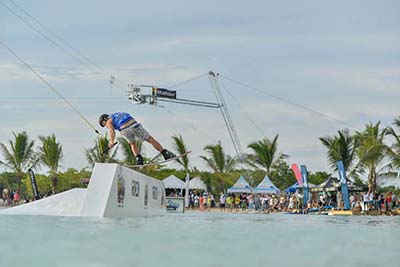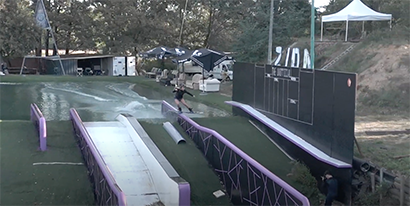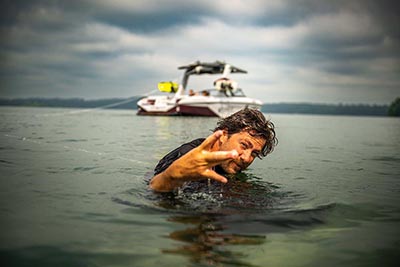18.2 | Matters: Insta-fication
Check out our Matters: Insta-fication section from the 2018 February and March Photo Annual issue!

Youtube advocate Steel Lafferty charging on Conway (photo: Mathis)
When I first got into to the wakeboard industry, almost 18 years ago, I remember going to to my local shop and watching VHS tapes for hours. This was my first experience ever seeing real professional riding. These were videos like MayDay, Incomplete and 12 Honkeys, videos that compiled the best riding to date. My younger brother and I would buy our favorites, take them home and watch them over and over until the tapes wore out. We knew every rider, every trick and all the words to every song that was in each video. Our collection started small, but grew each time a new feature film was released. The time that it took to see new shots and new tricks seemed to drag on forever and when a new video dropped it was like Christmas. At the time I had no idea how much energy went into each of those full videos, all I knew was I wanted more and I wanted it now.
Waiting months, or even a year, for your favorite rider’s new section is something foreign to kids just getting into the sport now. Riders these days have YouTube channels where they put out content each week, Instagram edits that are up almost immediately after their set or you can follow them on SnapChat where you can see what they are doing right that second. Many wakeboarders have become social media kings and queens. They incorporate it into their everyday life. We now know what new tricks riders are doing, as well as what they had for breakfast, what workouts they’re doing and who’s throwing a party. It’s become a way that the average joe can feel connected to their favorite athletes.
This need for constant content has been able to push the sport and spread riding at an accelerated rate over the past few years. If one rider is able to see what others are doing it can motivate them to get off their ass and work harder. It has also been the fuel for spreading trends. Look at the Valdosta Space Mob crew. Two or three years ago they were the only ones doing fake-out spins on rails or heavy butters. Now anytime you watch a cable edit, those tricks seem to be standard. The guys at Valdosta were so consistent with putting out content, via their social media, you now see kids from Europe, Asia or Dubai with skinny stances, buttering all over the park. Now that is real influence.
YouTube is becoming also becoming a stronger force in the wakeboard scene. One of the first wake videos that I owned was Shaun Murray’s Detention. If you aren’t familiar, it pretty much set the gold standard for instructional videos. The medium did have some of its flaws though. Being that it was a video, you weren’t able to talk to Shaun and ask him to explain a trick that wasn’t mentioned in the video. Today you’ve got guys like David O’Caoimh who uses his channel to teach tricks. He will even answer questions that are left in the comments and take suggestions for new tricks to teach.
Some of my favorite videos in the past weren’t all about the wakeboarding. If you watch any of the old Pointless Production videos they were filled with all kinds of antics. They showed party footage, pranks or just what their day-to-day life looked like. As a kid I wanted to feel like I knew those riders somehow. Through the social media, fans and viewers are getting that. You can almost feel like you are at the party with some of these guys. Granted, a lot of the guys share too much. You don’t really care who had avocado toast for breakfast but, it still offers an experience that I never had access to when I was a kid.
To all the positives that have come from social media in our sport it has also been a bit of a double edged sword. Riders are expected to have someone with them at all times who is willing to shoot. It has also made the industry a bit of a bragging contest, letting some riders outshine others based on their personality and camera presence. Some may argue that it has taken away from the quality of video being viewed, since it needs to come so often, rather than taking months to produce and refine. It has also led to gimmicks, where some videos being put out are made for the general public, and aren’t focused on the riding enough. That being said, the positives on the sport seem to outweigh the negatives.
Wakeboarding isn’t the only sport that is going through this social media phenomenon. If you look at surfing, snowboarding, BMX or just about any other action sport you will find the same trend. The internet has made our attention spans shorter than ever and everyone needs instant gratification. These social media platforms allow everyone to stay connected more than ever, and through that connection we have the ability to grow wakeboarding in ways that never seemed possible back when we were all watching VHS’s in our local shops.
By: Gunnar Shuler
Tags
Articles matters Photo Caption: Youtube advocate Steel Lafferty charging on Conway Insta-fication When I first got into to the wakeboard industry almost 18 years ago I remember going to to my local shop and watching VHS tapes for hours. This was my first experience ever seeing real professional riding. These were videos like MayDay Incomplete and 12 Honkeys videos that compiled the best riding to date. My younger brother and I would buy our favorites take them home and watch them over and over until the tapes wore out. We knew every rider every trick and all the words to every song that was in each video. Our collection started small-
#hottake
-
I'll wait a year for a crafted video part over shots of breakfast, golf, or working out any day. Quality>Quantity
-
Sometimes it feels like the soul has been stolen

























